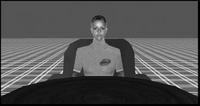 After a social interaction, participants rate people who mimicked their movements or speech more favourably than they rate people who didn’t mimic them, even if they were unaware of the mimicry – a phenomenon that’s been dubbed the chameleon effect. Now Jeremy Bailenson and Nick Yee at Stanford University have shown this social effect of mimicry still occurs even when people are mimicked by what they know is a digital, computerised ‘agent’ seen in a virtual reality graphics environment, rather than by another human.
After a social interaction, participants rate people who mimicked their movements or speech more favourably than they rate people who didn’t mimic them, even if they were unaware of the mimicry – a phenomenon that’s been dubbed the chameleon effect. Now Jeremy Bailenson and Nick Yee at Stanford University have shown this social effect of mimicry still occurs even when people are mimicked by what they know is a digital, computerised ‘agent’ seen in a virtual reality graphics environment, rather than by another human.Sixty-nine male and female student participants wore a virtual reality helmet that displayed a 3-D image of the head and shoulders of a digital agent (see picture). For half the participants, the digital agent precisely mimicked their head movements with a four-second delay. For the other control participants, the digital agent did not mimic their movements, but instead moved its head as the previous participant had done. Eight participants detected they were being mimicked and were omitted from the analysis.
The digital agent spoke for 195 seconds about a proposed university campus security policy. After the experiment, all the participants answered questions about what the agent had said and what they thought of the agent. The digital agent was rated as more persuasive and likeable by participants whose head movements it had mimicked than by participants it didn’t mimic, thus suggesting the chameleon effect works for computers too.
As electronic communications become more sophisticated the researchers said their finding suggested digital mimicry could be used to manipulate and persuade. “Whether in immersive virtual reality, on-line chat rooms, or video games, algorithmic mimics may become commonplace, with agents mimicking users as frequently as their designers want, or as subtly or as obviously as they are programmed to do”, they said.
_________________________________
Bailenson, J.N. & Yee, N. (2005). Digital chameleons. Automatic assimilation of nonverbal gestures in immersive virtual reality environments. Psychological Science, 16, 814-819.
You have read this article Social
with the title Mimicry the best form of flattery for computers too. You can bookmark this page URL http://psychiatryfun.blogspot.com/2005/10/mimicry-best-form-of-flattery-for.html. Thanks!





No comment for "Mimicry the best form of flattery for computers too"
Post a Comment